|
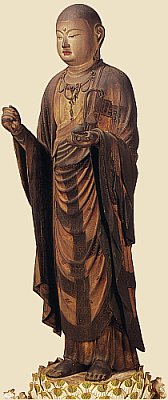
Jizo Bosatsu 地蔵菩薩
By Kaikei, Painted Wood
H 90.6 cm, 13th Century
Tōdaiji Temple 東大寺 in Nara
|
|
 Busshi Kaikei 快慶 (died approx. +1226) Busshi Kaikei 快慶 (died approx. +1226)
Kaikei was an acclaimed Kei-schoool sculptor from the Kamakura period, perhaps just as famous as Unkei in those days. The two were contemporaries. Both sprang from the workshop of Kōkei (Kokei) 康慶, the biological father of Unkei. Kaikei was one of Kōkei’s most brilliant apprentices, but he was not related by blood.
Kaikei and Unkei worked together on various projects, and the two are commonly considered the best Kei sculptors of the Kamakura era. A friendly rivalry existed between the two, with Kaikei actually assigned greater responsibilities than Unkei until at least the early 13th century. Kaikei was awarded Hokkyo (Hōkyō) 法橋 rank in +1203, and Hogen (Hōgen) 法眼 rank in +1208, some of the highest titles bestowed on artists in those times.
Art scholars typically divide his extant work into three periods: (1) his early years, when his statuary reflected the vivid realism of the Kei school; (2) his middle period, from around +1200 to +1208, a period when he developed his own unique statuary style called Annami 安阿弥 and gained the Hōkyō 法橋 rank; and (3) his late period, from +1208 until his death around +1223 / 26, his Hōgen 法眼 period, when he made many small images of Amida Buddha.
His Annami style was copied, formalized, and stereotyped in coming centuries, never again to reach its earlier brilliance.
THREE SCHOOLS OF SCULPTURE
ALL SPRANG FROM JOCHO’S WORKSHOP
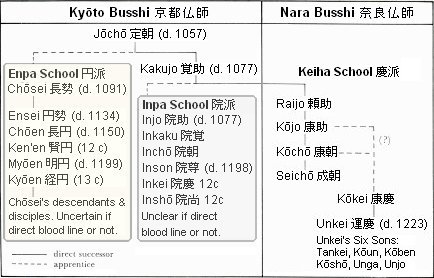
|
Note: The above chart is based in part on one appearing in Mori Hisashi’s book Sculpture of the Kamakura Period (ISBN 0-8348-1017-4). The KEIHA school rose to prominence under Kokei, Unkei, and Kaikei. As for Unkei’s father, Kokei, little is known of his lineage. Most think he was an apprentice of either Kojo or Kocho.
|
|
Artists of Japan’s Kei School
See Keiha School Page for Reviews of Below Artists
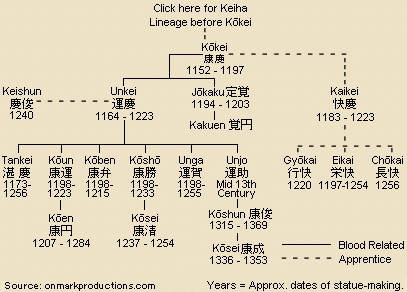
Data from Sculpture of the Kamakura Period (ISBN 0-8348-1017-4)
Also from 日本史小百科 ・彫刻 ・久野健編 ・近藤出版社刊

|
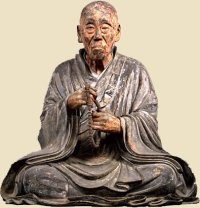
Monk Chōgen Shunjōbō 重源俊乗坊
Painted Wood, H 82 cm
Early 13th C. Artist unknown.
Shunjōdō 俊乗堂, Tōdaiji 東大寺, Nara
Realism in Portraiture
A hallmark of the Kei School
in the Kamakura Period
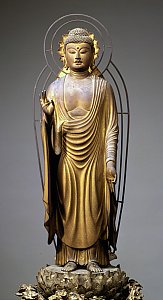
Amida Buddha (Kaikei)
Painted Wood, H 100 cm, +1202
Shunjōdō 俊乗堂, Tōdaiji 東大寺, Nara
|
|
 ANNAMI 安阿弥 ANNAMI 安阿弥
Kaikei is credited with creating an independent sculptural style known as Annami 安阿弥, also called Annamiyō (Annamiyo) 安阿弥様, which literally means “Annami Style.” The name of this style stems from Kaikei’s own unique inscription, for he signed many of his works “Kaikei of the Buddhist name AN AMIDA BUTSU,” writing AN in Sanskrit. He received this special Buddhist name from his friend, the Buddhist priest Chōgen (Chogen) 重源, the latter a famous monk (+1121-1206) who introduced the so-called Daibutsu Style (Daibutsuyō) 大仏様 of architecture to Japan, which he had learned while visiting China. See photo at right.
Chōgen was a luminary of the period who raised funds for the rebuilding of the Daibutsuden 大仏殿, the giagantic "Buddha Hall" at Tōdaiji Temple 東大寺 in Nara, which had been burnt to the ground in +1180 during the Genpei War 源平合戦 (Genpei Kassen, + 1180 to 1185). Chōgen was also a fervent believer in Amida Buddha 阿弥陀如来 and Pure Land faith (Jōdokyō 浄土教), and from +1183 he started giving his friends Buddhist names that contained the name Amida.
Annami-style sculpture was based on the realism of the Kei School, but it added a delicate grace and dignified beauty that most found charming and irresistible. The sculpture of Amida Nyorai 阿弥陀如来 at the Shunjōdō 俊乗堂 of Tōdaiji Temple in Nara displays the characteristics of Kaikei’s Annami form.
The sculpture of Amida Nyorai at the Saihōin (Saiho-in) 西方院 of Tōshōdaiji (Toshodaiji) Temple 唐招提寺 in Nara is another good example, as is that of a well-preserved statue of Jizō Bosatsu at Tōdaiji Temple (presented below).
Kaikei's Annami style was carried forward by his apprentices and followers, including Gyōkei (Gyokei) 行快, Chōkai (Chokai) 長快 , and Eikai 栄快. However, in the centuries following Kaikei’s death, the Annami style was copied, stereotyped, and formalized to such a degree that it ultimately lost much of its earlier brilliance and beauty.

Extant Works by Kaikei
Below treatment follows that of author Mori Hisashi in Sculpture of the Kamakura Period.
|
Early Years up to around +1200. Vivid Realism, in Manner of Kei School. Nicely proportioned faces, moderately fleshy bodies, free-flowing robes. Keikai also experimented with Sung styles from China, and those from Japan’s early Fujiwara era (10th & 11th centuries) and Nara period (late 8th century). From these he developed his acclaimed Annami Style.
|
|
- Miroku Bosatsu 弥勒菩薩, the Bodhisattva of the Future. Dated +1189. Height 106.6 cm. Now located at the Museum of Fine Arts, Boston. Wood (cypress) with gold and inlaid crystal; split-and-join construction. Ownership History: Until 1906 in the collection of Kōfuku-ji Temple 興福寺 in Nara. In 1920 it was purchased from the Estate of Okakura Kakuzo. Photo at right and below courtesy Museum of Fine Arts, Boston.
- Miroku Bosatsu 弥勒菩薩像, Sanbo-in (Sanbōin) 三宝院, Daigoji Temple 醍醐寺, Kyoto, dated +1192. Wood with gold leaf. See next two photos.
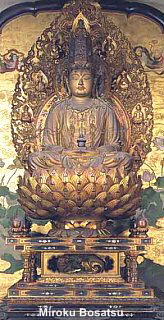 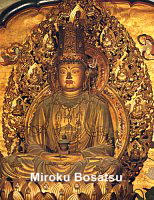 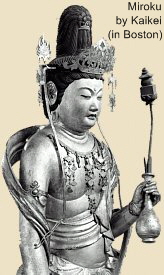
- Amida Triad 阿弥陀三尊, Jodoji (Jōdoji) Temple 浄土寺 in Hyōgo Prefecture. See photos below.
- Shaka Nyorai 釈迦如来, Enpuku-in 円福寺, Shiga Prefecture, dated +1197.
- Fudō Myō-ō (Fudō Myō-ō) 不動明王, Shoju-in (Shōjuin) 性寿院, Kyoto.
- Amida Nyorai 阿弥陀如来, Saiho-ji (Saihōji) 西芳寺, Nara Prefecture.
- Amida Nyorai 阿弥陀如来, Matsuno-o-dera 松尾寺, Kyoto Prefecture.
- Miroku Bosatsu 弥勒菩薩, Todaiji (Tōdaiji) Temple 東大寺 in Nara, made sometime in 1190s.
- Shaka Nyorai 釈迦如来, Bujo-ji (Bujōji) 峰定寺, Kyoto, dated +1199.
- Shaka Nyorai 釈迦如来, Kengo-in (Kengōin) 遣迎院, Kyoto, dated around +1194-1199.
- Amida Nyorai 阿弥陀如来, Kengo-in (Kengōin) 遣迎院, dated around +1194-99.
- Shūkongōshin (Shukongoshin) 執金剛神. Also read Shikongōjin. Also called Kongōshu 金剛手, Jikongō 持金剛, or Kongō Rikishi 金剛力士 (Skt. = Vajrapani or Vajradhara), as well as a statue of Jinja Taishō (Jinja Taisho) 深沙大将. Located at Kongō-in (Kongo-in) 金剛院, Kyoto Prefecture.
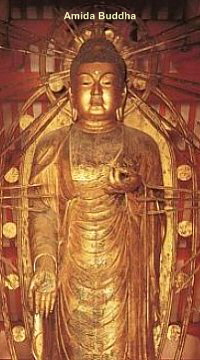 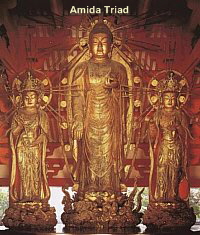
Amida Triad by Kaikei. central Amida image (H = 371 cm).
Seishi Bosatsu 勢至菩薩 on right, Kannon 観音菩薩 on left.
Lacquer & gold leaf over wood. Dated +1197. Jōdoji (Jodoji) Temple 浄土寺, Hyōgo Prefecture.

|
ANNAMI STYLE REACHES PERFECTION
Annami 安阿弥, also called Annamiyō (Annamiyo) 安阿弥様. Around +1200 to +1208. Realism of the Kei school still evident, but a new delicate beauty emerges, one featuring great attention to detail, sharp and graceful carving of robes and elegantly ordered drapery, and faces with grace and dignity.
|
|
- Kujaku Myō-ō (Kujaku Myo-o) 孔雀明王, Peacock King, Kongōbuji (Kongobuji) Temple 金剛峯寺, Mt. Kōya (Koya) 高野, Wakayama Prefecture, dated +1200. See photo below.
- Amida Nyorai 阿弥陀如来, Kozo-ji, Hiroshima Prefecture, dated +1201
- Hachiman 八幡 in Guise of a Buddhist Priest (Sōgyō Hachiman 僧形八幡), Tōdaiji Temple 東大寺, dated +1201. See photo below.
- Amida Nyorai 阿弥陀如来, Henjōkōin (Henjoko-in) 遍照光院, Mt. Kōya 高野, Wakayama Prefecture.
- Amida Nyorai 阿弥陀如来, Tōdaiji Temple 東大寺, Nara, dated +1202.
- Fudō Myō-ō (Fudo Myo-o) 不動明王, Sanbōin (Sanbo-in) 三宝院, Daigo-ji Temple 醍醐寺, dated +1203.
- Dainichi Nyorai 大日如来, at Tokyo University of Arts.
- Jizō Bosatsu (Jizo Bosatsu) 地蔵菩薩, Tōdaiji Temple 東大寺, Nara. See photo below.
- Tōdaij Temple 東大寺, Restoration Period
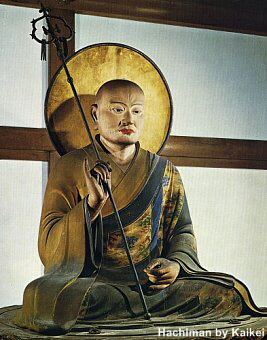
Shintō Deity Hachiman 神道の神様八幡 (by Kaikei)
Hachiman represented as a Buddhist Monk. Painted Wood. H 87 cm. Dated +1201.
Tōdaiji Temple 東大寺. Photo Courtesy temple catalog.
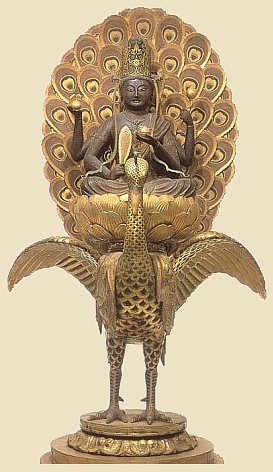
Kujaku Myō-ō (Kujaku Myo-o) 孔雀明王 by Kaikei. Painted Wood, Dated +1200.
H = 78.5 cm. Kongōbuji (Kongobuji) Temple 金剛峯寺. Mt. Kōya (Koya) 高野 in Wakayama Prefecture.
Photo: Handbook on Viewing Buddhist Statues. By Ishii Ayako. ISBN 4-262-15695-8. Japanese only.

|
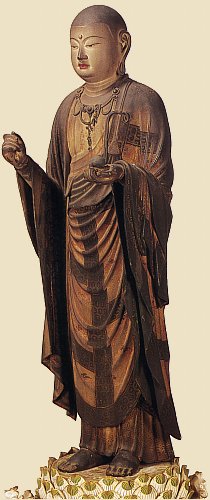
|
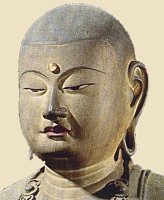
Jizō Bosatsu 地蔵菩薩
By Kaikei. Painted Wood
H = 90.6 cm, Early 13th Century
Tōdaiji Temple 東大寺, Nara
Kaikei’s
Annami Style
Reaches Perfection
Photos courtesy
日本の仏像100選
ISBN4-391-12629-X
|
|

|
Final Period. Made many small statues of Amida Nyorai, but somehow Kaikei’s work in the final years fails to match its earlier brilliance.
|
|
- Amida Nyorai 阿弥陀如来, Toju-in (Tōjuin) 等樹院, Okayama Prefecture, dated +1211.
- Amida Nyorai, Korinji (Kōrinji) Temple 高林寺, Nara Prefecture, +1221.
- Amida Nyorai, Kodai-in (Kōdai-in) Temple 光台院, Wakayama Prefecture, +1221.
- Amida Nyorai, Saiho-in Temple (Saihōin) 西方院, Nara, around +1221.
- Amida Nyorai, Daigyo-ji Temple (Daigyōji) 大行寺, Kyoto, around +1221.
- 16 Disciples of Shaka Nyorai 釈迦十大弟子尊像, Daihō-onji Temple 大報恩寺, Kyoto.

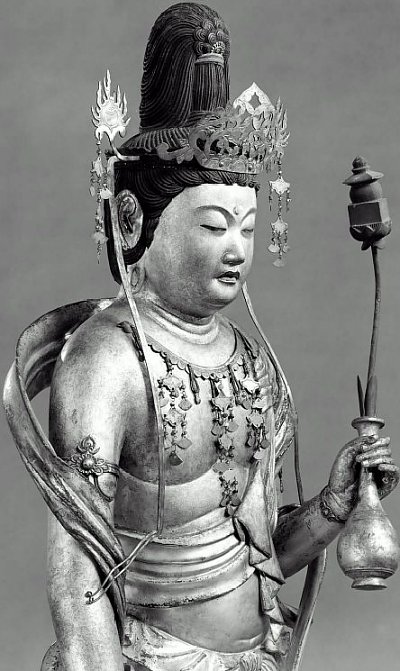
Miroku Bosatsu 弥勒菩薩, the Bodhisattva of the Future.
By Kaikei. Dated +1189. Height 106.6 cm. Now located at the Museum of Fine Arts, Boston.
Wood (cypress) with gold & inlaid crystal; split-and-join construction. Photo Museum of Fine Arts, Boston.
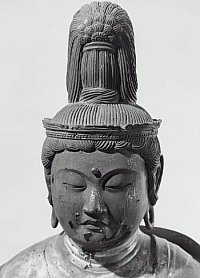
Closeup of prior photo of Miroku.
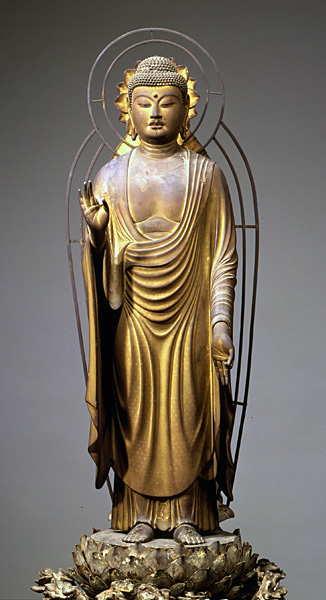
Amida Nyorai 阿弥陀如来 by Kaikei. Kaikei’s Annami Style Reaches Perfection
Painted Wood, H 100 cm, Dated +1202. Tōdaiji Temple 東大寺, Nara 奈良. Photo Nara Nat’l Museum.

Comparing Unkei and Kaikei. In his book Sculpture of the Kamakura Period, author Mori Hisashi offers a tentative analogy between the Kamakura-period pair Unkei and Kaikei and their counterpart pair from the Italian Renaissance -- Michelangelo and Raphael. Michelangelo represented the art of power and passion (read Unkei), while Raphael skillfully painted pictures of harmonious beauty that incorporated the styles of many artists (read Kaikei). Mori also points out that Raphael’s most famous piece, the Madonna of Christianity, is a figure very much akin to Amida Nyorai in Japanese Buddhism, and statues of Amida were Kaikei’s speciality.

Kaikei’s Students. Three other important Kei artists sprang from Kaikei’s workshop, and carried on his Annami-style sculpture. Also see lineage chart above.
- Gyōkai 行快 (Gyokai). Active in first-half of the 13th century. Senior apprentice of Kaikei. Awarded Hōgen (Hogen) 法眼 rank. Two extant works: (1) Shaka Nyorai 釈迦如来 at Daihō-on-ji Senbon Shakadō 大報恩寺・千本釈迦堂 and (2) one smaller statue of the 1000-Armed Senju Kannon 千手観音 at Sanjūsangendō (Kyoto). However, the Shaka statue is probably a reproduction, as the original was reportedly damaged or destroyed in earlier centuries.
- Eikai 栄快. Apprentice to Kaikei. Active in mid-13th century.
- Chōkai 長快 (Chokai). Apprentice to Kaikei. Active in mid-13th century. See below B/W photo.
|
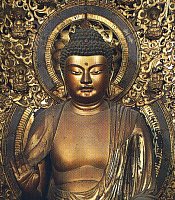
Shaka Nyorai 釈迦如来
Work by Gyōkai 行快
Lacquer & gold leaf over wood. H = 91 cm.
13th Century. Daihō-onji Temple 大報恩寺 Kyoto
|
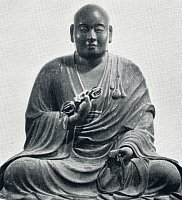
Kōbō Daishi (Kobo Daishi) 弘法大師
By Chōkai 長快, Painted Wood,
H = 69.4 cm, 13th Century
Roku Haramitsuji Temple 六波羅蜜寺 in Kyoto
|
|
Photo of Shaka Nyorai courtesy of History of Japanese Buddhist Statuary (日本仏像史),
Bijutu Shuppan-sha 2001, ISBN4-568-40061-9. Photo of Kōbō Daishi
courtesy of Sculpture of the Kamakura Period by Mori Hisashi.
|
|

ENGLISH & JAPANESE RESOURCES
- JAANUS. Japanese Architecture & Art Net Users System. Online database devoted to Japanese art history. Compiled by the late Dr. Mary Neighbour Parent, it covers both Buddhist and Shintō deities in great detail and contains over 8,000 entries.
- Heibonsha, Sculpture of the Kamakura Period. By Hisashi Mori, from the Heibonsha Survey of Japanese Art. Published jointly by Heibonsha (Tokyo) & John Weatherhill Inc. A book close to my heart, this publication devotes much time to the artists who created the sculptural treasures of the Kamakura era, including Unkei, Tankei, Kokei, Kaikei, and many more. Highly recommended. 1st Edition 1974. ISBN 0-8348-1017-4. Buy at Amazon
 . .
- Classic Buddhist Sculpture: The Tempyo Period. By author Jiro Sugiyama, translated by Samuel Crowell Morse. Published in 1982 by Kodansha International. 230 pages and 170 photos. English text devoted to Japan’s Asuka through Early Heian periods and the development of Buddhist sculpture during that time. ISBN-10: 0870115294. Buy at Amazon.

- The Great Age of Japanese Buddhist Sculpture, AD 600-1300. By Nishikawa Kyotaro and Emily J Sano, Kimbell Art Museum (Fort Worth) and Japan House Gallery, 1982. 50+ photos and a wonderfully written overview of each period. Includes handy section on techniques used to make the statues. The Great Age of Japanese Buddhist Sculpture (AD 300 - 1300)
 . .
- Comprehensive Dictionary of Japan's National Treasures. 国宝大事典 (西川 杏太郎). Published by Kodansha Ltd. 1985. 404 pages, hardcover, over 300 photos, mostly color, many full-page spreads. Japanese Language Only. ISBN 4-06-187822-0.
- Numerous Japanese-language temple and museum catalogs, magazines, books, and web sites. See Japanese Bibliography for extended list.

  JAPANESE WEB SITES JAPANESE WEB SITES

|